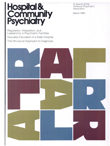The Role of the Hospital Milieu in Structural Diagnosis
Abstract
The authors have found the structural approach to diagnosis to be a valuable tool in classifying ill-defined mental illnesses. That approach presumes there are discrete levels of mental functioning: neurotic, borderline, and psychotic. Each can be differentiated by identifying the degree of identity integration, the level of defensive operations, and the degree of reality testing. Two case illustrations are used to describe how the dynamic role of the hospital milieu can be used in conjunction with individual treatment to make an accurate diagnosis. The application of this approach to the diagnosis of adolescents is emphasized.
Access content
To read the fulltext, please use one of the options below to sign in or purchase access.- Personal login
- Institutional Login
- Sign in via OpenAthens
- Register for access
-
Please login/register if you wish to pair your device and check access availability.
Not a subscriber?
PsychiatryOnline subscription options offer access to the DSM-5 library, books, journals, CME, and patient resources. This all-in-one virtual library provides psychiatrists and mental health professionals with key resources for diagnosis, treatment, research, and professional development.
Need more help? PsychiatryOnline Customer Service may be reached by emailing [email protected] or by calling 800-368-5777 (in the U.S.) or 703-907-7322 (outside the U.S.).



